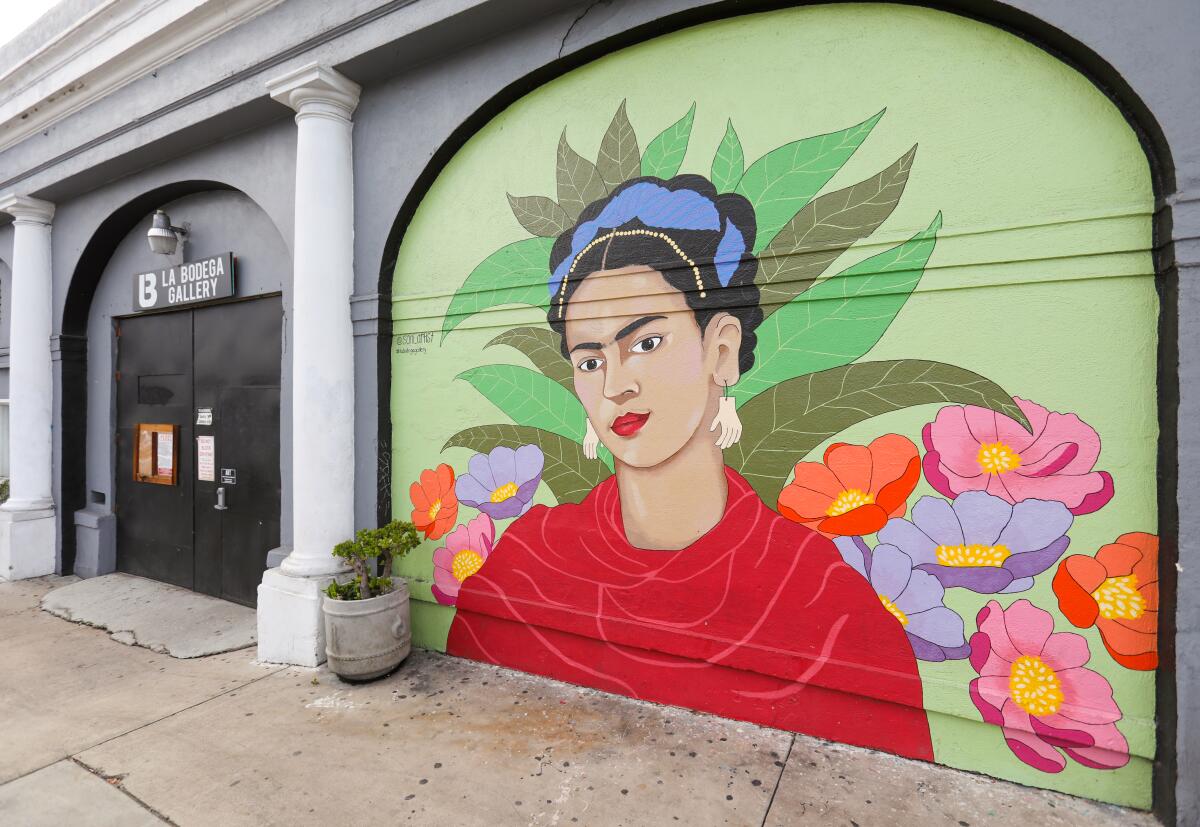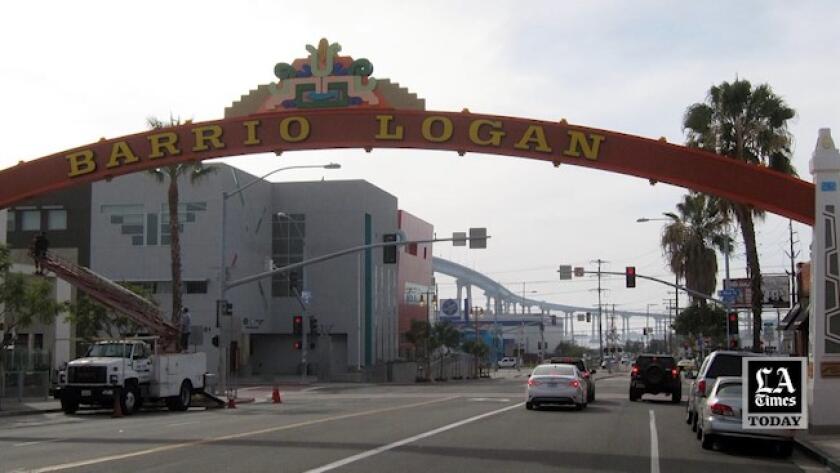Column: ‘Gentefication’ is complicated. One vibrant barrio shows a way forward

- Share via
“Gentefication,” a Spanglish term for gentrification led by a barrio’s own Latinx people, or gente, has a mixed reputation.
Critics argue it’s no different from gentrification: displacing vulnerable residents and changing a community’s character to indulge wealthier and whiter tastes. Defenders claim it can bring socially responsible development and preserve a neighborhood’s culture.
The complexities have inspired TV shows like the Netflix series “Gentefied” and the Starz series “Vida,” both featuring Boyle Heights, one of the best known examples of gentefication.
But closer to the Mexican border in my hometown of San Diego, Barrio Logan has been grappling with those thorny issues as well — and now, it has a chance to demonstrate that gentefication doesn’t have to come at the expense of marginalized residents.
Known for cruising lowriders and Chicano Park’s murals, the barrio, with mixed residential and industrial use, sits beside the naval base and Nassco shipyard on San Diego Bay. The neighborhood’s residents have one of the state’s highest asthma rates, very likely connected to traffic and industrial pollution.
The blue-collar Mexican American barrio has become a hub of tourism and investment as its vibrant art scene has gained recognition in recent years. In 2017, it was named one of 14 California Cultural Districts, and Chicano Park was designated a national historic landmark. More middle-class whites have been lured to the neighborhood, with rising rents displacing longtime local families.
Next week, the City Council will review a community plan that would reserve 15% of the barrio’s new housing for low-income residents and give locals priority for 75% of new affordable units, among other things. It would create a buffer zone between homes and industrial land, building on a 2013 council-approved plan that was derailed when the shipbuilding industry placed it on a 2014 primary election ballot.
“Barrio Logan has been affected by environmental racism for a very, very long time,” Julie Corrales, a policy advocate at the Environmental Health Coalition, told me. Protections for residents are long overdue.
Although I grew up southeast of the barrio, it’s a big part of my family history. After emigrating from Mexico, my father worked a decade at the shipyard, suffering molten-steel burns and other injuries until he was laid off with hundreds of workers upon completion of the Exxon Valdez. Then he helped his parents build a meat market in the ’80s that remains part of the barrio today.
In 2018, I threw my first book’s publication party at the Mexican-owned La Bodega Gallery, which was forced to close the next year, as was the Chicano Art Gallery, because of rent hikes.
It was heartbreaking to see the bustling Chicano art scene, including monthly art crawls that drew thousands of visitors, deteriorate months before COVID. La Bodega Gallery’s co-operator Soni López-Chávez told me it was disheartening to see greedy landlords use the economic success she helped create to price her and others out. But she doesn’t think the barrio’s art scene will die.
She pointed to Chicano Park, built in the ’70s as an act of protest after the construction of Interstate 5 tore the community apart. Murals on I-5 on-ramps and pillars of the Coronado Bridge depict scenes of the Chicano civil rights struggle, which remain an inspiration.
I recently visited Alberto López Pulido, chair of the University of San Diego’s ethnic studies department. He leads tours of the park, and fears new hipsters in the neighborhood will change things. “I don’t think people really understand what the park represents,” he said.
We stopped by a mural of Anastasio Hernández Rojas — a Mexican man who was repeatedly tased and beaten to death by a mob of border officials at the San Ysidro Port of Entry in 2010. The case — under review by the Inter-American Commission on Human Rights — is a horrific reminder of racist state violence, but the community has also made it a rallying point.
“If Chicano Park wasn’t there, everything would’ve been wiped out a long time ago,” Hector Villegas, a longtime artist and activist from the barrio, told me. “It’s our anchor.” He also said it’s time for San Diego to recognize Barrio Logan’s outsize value. “We give so much to this city, but it’s not reciprocated.”
Because the California Coastal Commission must review the community plan along with the City Council, it could be another two to three years before housing and environmental protections take effect. And since the plan governs only new developments, residents need other anti-eviction and rent control measures, too.
Meanwhile, local business owners are linking arms to try to survive. Claudia Biezunski-Rodríguez, a barrio resident and owner of the clothing store Sew Loka, formed a nonprofit this year to improve access to resources such as grants and street vendor rights education.
During the pandemic, she gave away hundreds of homemade face masks and organized collective outdoor events on Saturdays to help small businesses. As she pointed out to me, “My success is based off my neighbor’s success, you know?”
After a recent visit to my grandparents’ carnicería, I skateboarded past a new Latinx bookstore called Libélula Books & Co. that was offering $1 books on tables outside. Inside, tall shelves brimmed with children’s books in Spanish and English and social justice titles by Black, Indigenous and queer authors. Co-owner Jesi Gutierrez, who taught and lived in the barrio for years, wants to create a community space where “the neighbors across the street can bring their kids here and the kids can walk to the bus stop and pass a bookstore every day.”
The pandemic has added to the community’s health and economic struggles. But people like Gutierrez left me hopeful that the barrio, with its powerful legacy of activism embodied in Chicano Park, will enter a new phase of greater strength.
- Share via
Watch L.A. Times Today at 7 p.m. on Spectrum News 1 on Channel 1 or live stream on the Spectrum News App. Palos Verdes Peninsula and Orange County viewers can watch on Cox Systems on channel 99.
More to Read
A cure for the common opinion
Get thought-provoking perspectives with our weekly newsletter.
You may occasionally receive promotional content from the Los Angeles Times.













